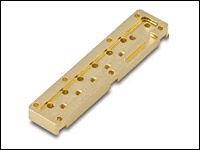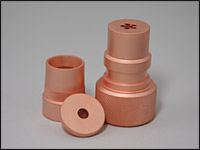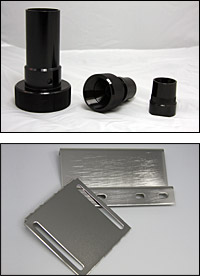Chemical Conversion Coatings - Copper, Electrolytic Nickel, Gold, Passivation, Tin, Dry Film Lubricants, Abrasive Blasting, Stress Relieve & Hydrogen Embrittlement Baking
Chemical Conversion Coatings
Also known as Chromate Conversion, Chem Film, Iridite and Alodine. Chromates are typically applied to raw aluminum as well as zinc, cadmium, phosphate, and other plating, to passivate and provide a sacrificial barrier, and/or a pre-paint coating. Bare aluminum and raw plated zinc and cadmium will rapidly corrode without a supplemental surface treatment and chromates provide a significant amount of corrosion protection which is typically measured by a salt spray test. Generally, the darker the color the greater the protection provided due to a thicker film.
- Mil-Dtl-5541
- Specific plating specifications require chromates in clear, yellow, black, olive drab and other colors.
Copper
Copper is utilized as a stand alone finish, as a base layer that may be buffed for nickel and chrome, as a masking for heat treatment, and alone with a blacking agent for specific applications. Copper's electrical conductivity properties allow use for printed circuit boards and other electrical products. Specifications:
- SAE-AMS-2418
- ASTM B 456 (When used with nickel and chrome)
Electrolytic Nickel
There are several types of electrolytic nickel plating including, black, bright, semi-bright, satin, and sulfamate (which has low stress values that increase ductility). Specifications:
- SAE-AMS-2403
- SAE-AMS-2404
- SAE-AMS-2405
- SAE-AMS-2424
- MIL-P-18317
Gold There are many different gold plating bath formulations that fall within four general categories for electronic or electronic applications: There are many different gold plating bath formulations that fall within four general categories for electronic or electronic applications:
- Soft, pure gold for the semiconductors
- Hard, bright gold for contacts
- Hard, bright gold for circuit board tabs
- Soft, pure gold from special baths for circuit boards
- MIL-G-45204, ALL TYPES & CLASSSES
- AMS 2422
- ASTM B 488
Passivation
Immersing stainless steels in specific solutions of acids removes residual ferrous steels from the surface that were acquired during fabrication, and creates a thin passive film on the surface on the stainless steel. The purpose is to eliminate the potential for galvanic cell activity between the dissimilar metals that creates corrosion. Specifications:
- ASTM A 380
- ASTM A 967
- SAE-AMS-2700
Tin
Tin plating has good electrical conductivity and is utilized on parts that require soldering, to increase anti-galling properties, for food containers as it is non-toxic, and for decorative or corrosion protection in a protected environment.
Dry Film Lubricants
Dry film lubricants create a layer or coating that reduces friction, binding, and wear. They can include additives that act as corrosion, oxidation, and rust inhibitors. Extra pressure additives prevent seizure, sticking or surface adhesion under high pressure conditions.
- MIL-L-23398, ALL TYPES
- MIL-PRF-46010, ALL TYPES
Abrasive Blasting
Abrasive/Mechanical blasting uses many types of abrasives to remove surface oxides or an existing coating prior to a finishing process. A number of specifications call out very specific preparation methods, including non-chemical processes. These procedures may be required by either the hardness of the base metal or the bonding methods of the coating being applied.
Stress Relieve Baking
When hardened or high strength steels in excess of Rc 33 are cold worked, stresses are introduced to the parts. These parts must be stress relieve baked for a minimum number of hours at specific temperatures prior to the plating process.
Hydrogen Embrittlement Baking
This phenomena occurs when high strength metals are subjected to cleaners, acids and plating baths that generate hydrogen bubbles. The bubbles seep into the laminations of the metal and concentrate at stress points creating an embrittlement, or high stress, condition that will cause the part to fail in use.
Specifications require individual baking times and temperatures for the plating process.
There are low embrittlement plating processes and specifications to address this issue.
|

